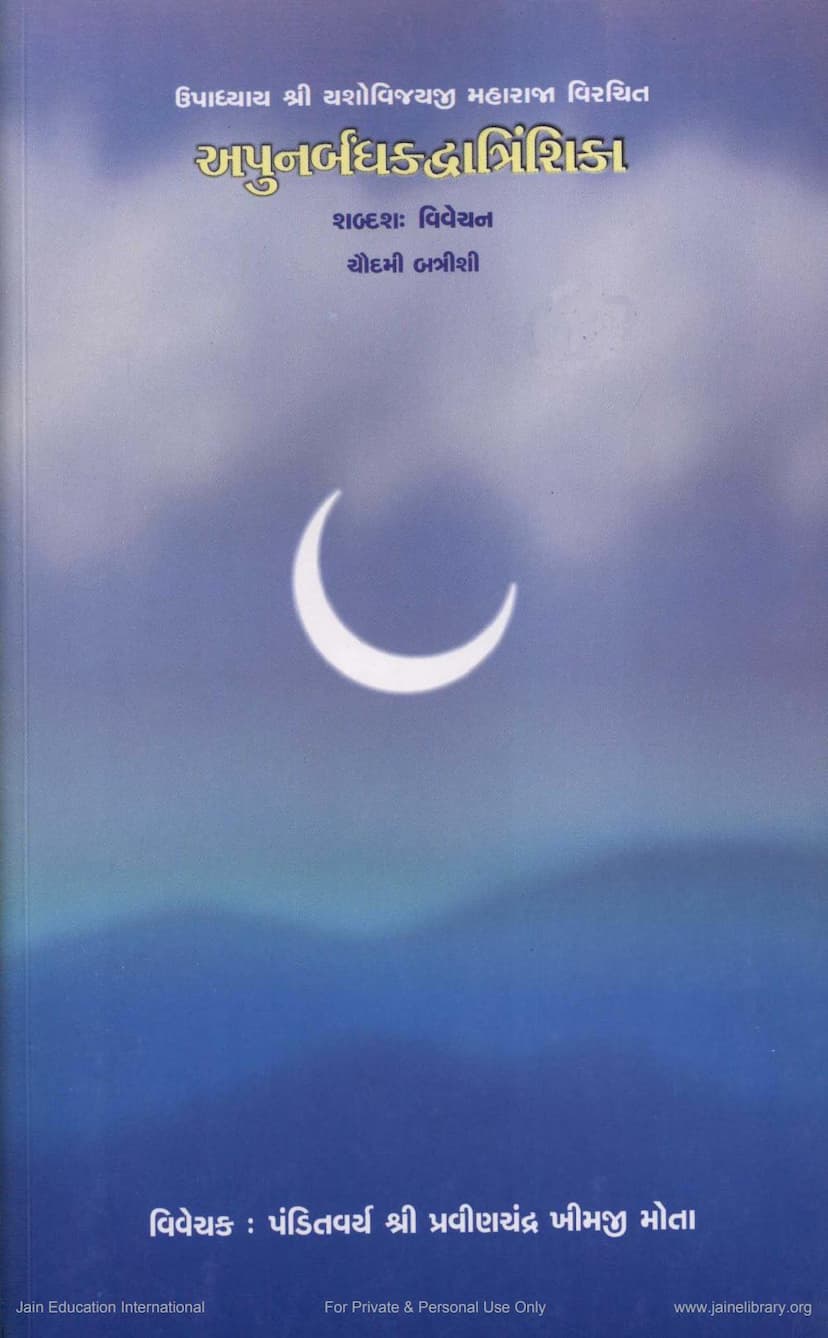Apunarbandhaka Dvantrinshika
Added to library: September 1, 2025

Summary
Here's a comprehensive summary of the Jain text "Apunarbhandhaka Dvātrimśikā" based on the provided pages:
Title: Apunarbhandhaka Dvātrimśikā (અપુનર્બંધક દ્વાત્રિંશિકા) Author: Mahāmahopādhyāya Yaśovijaya Upādhyāya Commentary (Vivechan): Pandit Śrī Pravinchandra Khīmajī Motā Publisher: Gītārtha Gaṅgā
Overall Context: The book is a commentary on the 14th chapter of Mahāmahopādhyāya Yaśovijaya Upādhyāya's larger work, the "Dvātrimśad Dvātrimśikā" (द्वात्रिंशद्द्वात्रिंशिका), which deals with thirty-two different philosophical topics, each explained in thirty-two verses. The "Apunarbhandhaka Dvātrimśikā" specifically focuses on the concept of the Apunarbhandhaka (અપુનર્બંધક), a soul that is on the path to liberation.
Publisher's Note (Prakāśakīya Vana): The publisher, Gītārtha Gaṅgā, aims to analyze and explain the profound philosophical principles embedded in Jain scriptures authored by great ācāryas like Ācārya Haribhadrasūri and Upādhyāya Yaśovijaya. This publication is a result of requests from the Jain community for lectures and commentaries on various subjects by respected scholars.
Introduction (Prāstavikā): Mahāmahopādhyāya Yaśovijaya Upādhyāya is highlighted as a master scholar, a sharp logician, and a prolific writer. His "Dvātrimśad Dvātrimśikā" is considered a masterpiece, enriched by his own commentary, the "Tattvārthadīpikā."
Chapter 14: Apunarbhandhaka Dvātrimśikā: This chapter follows the chapter on "Muktiadvēṣa Prādhānya Dvātrimśikā" (મુક્તિઅદ્વેષપ્રાધાન્ય દ્વાત્રિંશિકા), which discussed the importance of indifference towards liberation itself as a form of service. The Apunarbhandhaka Dvātrimśikā then describes the Apunarbhandhaka, who is the initial qualified aspirant for the path of yoga (spiritual practice leading to liberation).
The Concept of Apunarbhandhaka:
- Origin: This state arises when the delusions (darśanamohīya karma) related to false beliefs (mithyātva) weaken, and the soul develops a negative approach towards worldly pleasures. This leads to the realization that worldly happiness is ultimately suffering, and what appears as happiness is merely an illusion or a temporary absence of pain.
- Definition: An Apunarbhandhaka is a soul that will not bind the highest state of delusion-causing karma (mohanīya karma) in the future. This signifies a great achievement where the soul has broken the potential to bind such intense karma.
- Beginning of True Religion: This state is considered the starting point of true spiritual practice, yoga, and the path to moksha.
- Characteristics:
- Their devotion to spiritual practice (dharma) is stronger than their attachment to worldly pleasures.
- Their latent pure consciousness awakens.
- The force of worldly attachments is broken.
- They develop the ability to discern virtues and vices.
- They begin to have auspicious inclinations.
- They develop qualities like generosity and kindness, similar to the waxing moon.
- Their nature is peaceful and noble.
- They contemplate the purpose, nature, and results of the world and its separation from the self, laying the groundwork for right faith (samyaktva).
- Subtle Errors: Despite these positive developments, due to the lingering influence of delusion-causing karma (mithyātva mohanīya karma), their understanding is not fully enlightened, leading to occasional errors born of ignorance.
- "Dravyānga" (Material Aspect): Their actions are considered dravyānga (material aspect of spiritual practice) because while they are oriented towards the spiritual path, they are not yet fully engaged in bhāva yoga (mental/internal yoga).
Key Themes and Concepts Discussed: The text delves into the following through the commentary on the verses:
- The Nature of Apunarbhandhaka: Its definition, the cause of its attainment, and its gradual development of virtues.
- Apunarbhandhaka as Primary "Purva Seva" (Preliminary Service): While others may perform preliminary services, the Apunarbhandhaka's service is considered primary and unadulterated.
- Stages of Apunarbhandhaka: The text differentiates between states of being mārgapatita (fallen from the path) and mārgābhimukha (oriented towards the path), which are considered specific stages of the Apunarbhandhaka.
- Difference in Preliminary Service: The distinction between the primary preliminary service of the Apunarbhandhaka and the "by-way-of-treatment" (upacāra) preliminary service of others (like sakṛdbandhaka).
- Nature of Apunarbhandhaka: Described as peaceful and noble, with a contemplative mind, inclined towards higher conduct.
- Contemplation of the World: Apunarbhandhakas reflect on the purpose, nature, and consequences of the world and its separation from the self. This contemplation is crucial for attaining right faith.
- Material Yoga in Apunarbhandhaka: The text explains that Apunarbhandhakas possess dravya yoga (material/external yoga) through their virtuous conduct, which serves as a cause for attaining bhāva yoga (mental/internal yoga).
- Bhāva Yoga in the Right-Faith Soul (Samyagdr̥ṣṭi): The commentary contrasts the dravya yoga of the Apunarbhandhaka with the bhāva yoga of the samyagdr̥ṣṭi soul, who has overcome intense attachment and aversion and possesses a pure vision of reality. The samyagdr̥ṣṭi experiences yoga continuously, even during worldly activities, due to their intention and wisdom.
- Types of Conduct (Anuṣṭhāna): The text discusses three types of pure conduct: viśayaśuddha (pure in objective/goal), svarūpaśuddha (pure in form/practice), and anubandhaśuddha (pure in continuity/consequence).
- Appreciating and Criticizing Conduct: The commentary analyzes how different types of conduct are praised or criticized based on their purity and their contribution to spiritual progress. While the Apunarbhandhaka's conduct is generally positive, the samyagdr̥ṣṭi's conduct is consistently praised for its absolute purity and efficacy.
- The Role of Three Reasons (Pratyaya): The text emphasizes that genuine spiritual progress and the attainment of the highest states depend on the conjunction of three reasons: self-determination (ātma-pratyaya), guidance from a guru (guru-pratyaya), and auspicious signs (liṅga-pratyaya).
- The Importance of Discrimination and Prudence: The commentary stresses that actions must be undertaken with careful consideration of one's own capacity, the teachings of the scriptures, and the guidance of a guru to ensure they lead to ultimate liberation and not to downfall.
Conclusion: The "Apunarbhandhaka Dvātrimśikā" serves as a detailed exposition of a crucial stage in the Jain spiritual path. It meticulously defines the characteristics of an Apunarbhandhaka, their contemplative nature, and their initial engagement with yoga through virtuous conduct. The commentary meticulously clarifies the subtle distinctions between different types of spiritual practices and the qualifying conditions for spiritual progress, emphasizing the ultimate goal of liberation and the path to achieve it through knowledge, faith, and conduct guided by scripture and wise counsel.